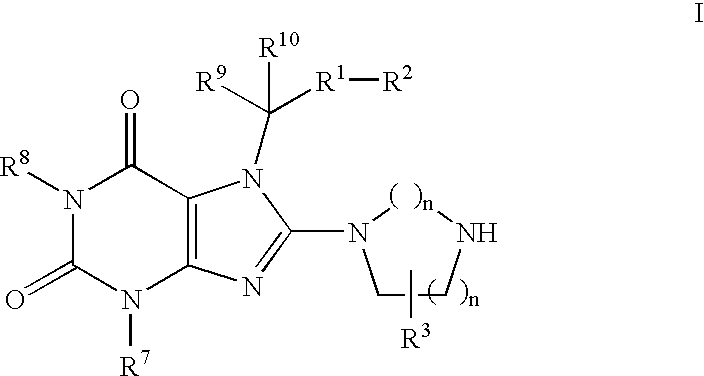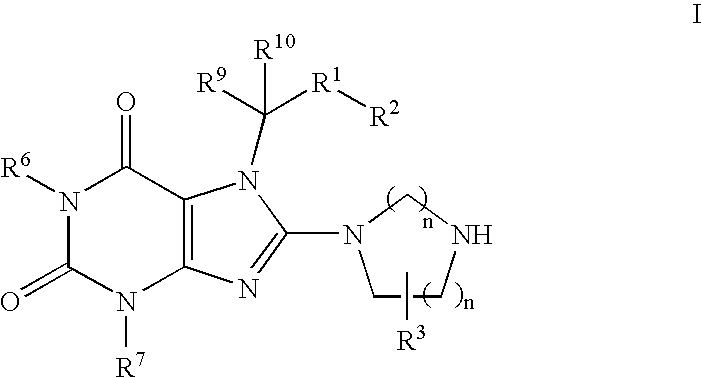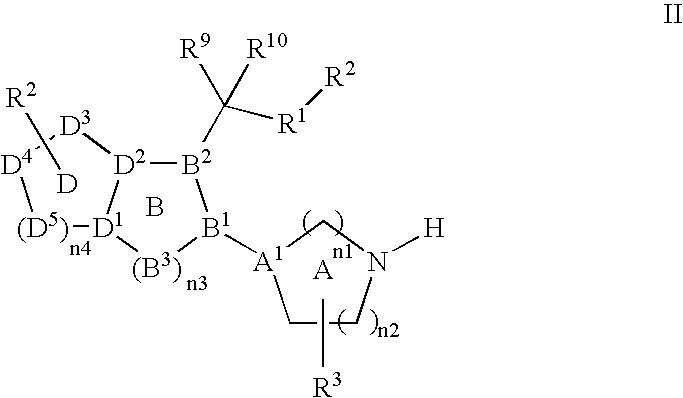Heterocyclic compounds, which are inhibitors of the enzyme DPP-IV
a technology of inhibitors and heterocyclic compounds, applied in the direction of biocide, drug composition, metabolic disorders, etc., can solve the problems of increasing the risk of premature death, no convincing pharmacological treatment currently available for reducing body weight effectively and acceptably, and insufficient initial weight loss. optimal therapeutic goal
- Summary
- Abstract
- Description
- Claims
- Application Information
AI Technical Summary
Problems solved by technology
Method used
Image
Examples
example 1
[0484]7-Benzyl-8-(6-hydroxymethyl-[1,4]diazepan-1-yl)-1,3-dimethyl-3,7-dihydropurine-2,6-dione. TFA
[0485]
Step A: Preparation of 1,4-dibenzyl-[1,4]diazepane-6-carboxylic Acid. Na-salt (1A)
[0486]N,N′-dibenzylethylenediamine (4.9 ml, 20.8 mmol) was dissolved in toluene (200 ml), triethylamine (8.94 ml, 64.5 mmol), and methanol (20 ml) and 3-bromo-2-bromomethylpropionic acid (5.12 g, 20.8 mmol) was added. The reaction mixture was heated to reflux for 24 hours. The solvents were evaporated and the remaining was redissolved in water (150 ml) and ethyl acetate (150 ml). The aqueous layer was acidified with 6N hydrochloric acid until pH=2, and the layers were separated. The aqueous layer was washed with ethyl acetate and then 10% aqueous sodium hydroxide was added until pH=12. The aqueous layer was washed with 4×150 ml of ethyl acetate, and then evaporated to dryness. The remaining was suspended in ethyl acetate (200 ml) and dry methanol (20 ml) and salts was filtered off. The mother liquor...
example 2
[0496]7-Benzyl-8-(6-hydroxy-[1,4]diazepan-1-yl)-1,3-dimethyl-3,7-dihydropurine-2,6-dione. TFA
[0497]
Step A: Preparation of 1,4-dibenzyl-[1,4]diazepan-6-ol (2A) N,N-dibenzylethylenediamine (4.9 ml, 20.8 mmol) was dissolved in toluene (200 ml), triethylamine (8.94 ml, 64.5 mmol), and 1,3-dibromo-2-propanol (4.53 g, 20.8 mmol) was added. The reaction mixture was heated to reflux for 4 days. The solvents were evaporated and the remaining was redissolved in water (150 ml) and ethyl acetate (150 ml). The aqueous layer was acidified with 6N hydrochloric acid until pH=2, and the layers were separated. The aqueous layer was washed with 3×100 ml of ethyl acetate and the combined organic material was dried with sodium sulphate, filtered and the solvent was evaporated. The crude product was purified by chromatography onsilica, using 5% methanol in dichloromethane as the eluent. Fractions containing the product were evaporated, to afford 3.59 g of 2A as an yellow oil in 59% yield.
[0498]1H-NMR (Me...
example 3
7-Benzyl-8-(3-hydroxymethyl-[1,4]diazepan-1-yl)-1,3-dimethyl-3,7-dihydropurine-2,6-dione. TFA
[0503]
Step A: Preparation of 1,4-dibenzyl-[1,4]diazepane-2-carboxylic acid methyl ester (3A)
[0504]N,N′-Dibenzylpropane-1,3-diamine (Sandstroem, J. et al, Tetrahedron; EN; 34; 1978; 371-378) (2.0 g, 7.86 mmol), methyl 2,3-dibromopropionate (1.28 ml, 7.86 mmol), and potassium carbonate (2.17 g, 15.72 mmol) were dissolved in dry dimethylformamide (125 ml) and methanol (20 ml) and the mixture was heated to reflux for 6 days. The reaction mixture was allowed to cool to room temperature and water (200 ml) and ethyl acetate (200 ml) were added. The aqueous layer was extracted with 2×200 ml of ethyl acetate, and the combined organic layers were dried with sodium sulfate, filtered and the solvent was evaporated. The crude product was purified by chromatography on silica, using a mixture of ethyl acetate and heptane 1:6 as the eluent. Fractions containing the product were evaporated, to afford 180 mg ...
PUM
 Login to View More
Login to View More Abstract
Description
Claims
Application Information
 Login to View More
Login to View More - R&D
- Intellectual Property
- Life Sciences
- Materials
- Tech Scout
- Unparalleled Data Quality
- Higher Quality Content
- 60% Fewer Hallucinations
Browse by: Latest US Patents, China's latest patents, Technical Efficacy Thesaurus, Application Domain, Technology Topic, Popular Technical Reports.
© 2025 PatSnap. All rights reserved.Legal|Privacy policy|Modern Slavery Act Transparency Statement|Sitemap|About US| Contact US: help@patsnap.com



